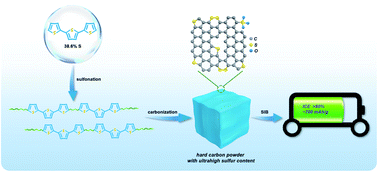High-sulfur-doped hard carbon for sodium-ion battery anodes with large capacity and high initial coulombic efficiency†
Abstract
As one of the most promising potential anodes for sodium ion batteries, hard carbon suffers from low specific capacity, which seriously hinders its further application. In the present work, a novel S-doped hard carbon material (SHC) with an ultrahigh S content of 15.91% is designed by a simple sulfonation treatment of terthiophene. Ex situ X-ray Photoelectron Spectroscopy, X-ray Diffractometer and Transmission Electron Microscope results demonstrate that the S atoms supply redox reaction sites with Na+ and lead to the formation of NaxS, thus endowing the SHC with superior Na storage performance. The SHC has a large reversible capacity of 777 mA h g−1, and it shows good cycling stability that a high capacity of 758 mA h g−1 is maintained after 1000 cycles, with no dramatic capacity loss. Meanwhile, it is notable that SHC-500 has a surprisingly high initial coulombic efficiency (ICE) of 84.4%, demonstrating good potential in practical use. Kinetics analysis reveals that the S atoms store Na through a dominant fast surface reaction, and then the SHC has good high-rate performance, e.g., a capacity of 353 mA h g−1 is delivered at a large current density of 10 A g−1.



 Please wait while we load your content...
Please wait while we load your content...